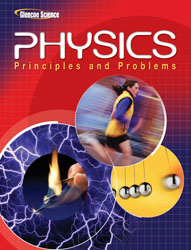1 A) All of an atom's positive charge and virtually all of its mass are in a tiny central core. B) Electrons contain so much energy that they can deflect α particles. C) Electrons are scattered throughout an atom like blueberries in a muffin. D) The amount of space occupied by the electrons in an atom is insignificant. 2 A) 3.19 eV B) 10.2 eV C) 12.1 eV D) 13.6 eV 3 n = 3) to the second energy level (n = 2). What is the wavelength of the emitted photon? In what part of the electromagnetic spectrum is this wavelength?<a onClick="window.open('/olcweb/cgi/pluginpop.cgi?it=jpg::::/sites/dl/free/0078807220/617936/cj.JPG','popWin', 'width=NaN,height=NaN,resizable,scrollbars');" href="#"><img valign="absmiddle" height="16" width="16" border="0" src="/olcweb/styles/shared/linkicons/image.gif"> (5.0K)</a> A) 7.50 × 101 nm; infrared B) 2.44 × 102 nm; ultraviolet C) 5.09 × 102 nm; visible D) 1.03 × 103 nm; infrared 4 A) Electrons travel in fixed orbits. B) Energy levels in an atom are quantized. C) Electrons have wave properties. D) Electrons are found in electron clouds. 5 A) –3.36 eV B) –4.54 eV C) –11.0 eV D) –12.2 eV 6 A) 242 nm; ultraviolet B) 420 nm; violet C) 633 nm; red D) 845 nm; infrared 7 A) the exact position and momentum of an electron B) the radius of an electron's orbit C) the probability that an electron is in a specific region D) the angular momentum of an electron 8 14 Hz. What was the transition?<a onClick="window.open('/olcweb/cgi/pluginpop.cgi?it=jpg::::/sites/dl/free/0078807220/617936/ck.jpg','popWin', 'width=NaN,height=NaN,resizable,scrollbars');" href="#"><img valign="absmiddle" height="16" width="16" border="0" src="/olcweb/styles/shared/linkicons/image.gif"> (9.0K)</a> A) E 3 to E 1 B) E 5 to E 2 C) E 1 to E 3 D) E 2 to E 5 9 laser stand for?A) light amplification by stimulated emission of radiation B) light amplification by spontaneous emission of radiation C) light amplification by stimulated excitation of radiation D) Luke's amazing, stupendous, extraordinary radiation 10 A) Coherent light is light that always has the same intensity. B) Coherent light has waves that are at the same point in their cycle at the same time. C) Coherent light is light that has a continuous spectrum. D) Coherent light always has waves that were produced by a process known as stimulated emission.














